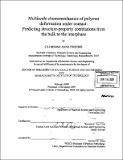Multiscale chemomechanics of polymer deformation under contact : predicting structure-property correlations from the bulk to the interphase
Author(s)
Tweedie, Catherine Anne
DownloadFull printable version (57.50Mb)
Other Contributors
Massachusetts Institute of Technology. Dept. of Materials Science and Engineering.
Advisor
Krystyn J. Van Vliet.
Terms of use
Metadata
Show full item recordAbstract
The development of nanoscale polymeric materials for mechanical applications necessitates advances in small-volume experimental techniques and analyses that reflect the viscoelastoplastic behavior of such materials. In this thesis, the time-dependence and response of homogeneous engineering polymers under confined contact loading are characterized as a function of polymer physical and structural properties. The validity of the time-independent metric indentation hardness Hi is evaluated through the combination of nanoindentation and atomic force microscopy imaging. In addition, the classic, time-dependent metric creep compliance J(t) is used to establish the experimental conditions necessary for linear elastic behavior for a set of thermoplastic and thermoset materials. For large indentations (hmax > 1 um), properties are tacitly assumed to reflect the properties of bulk polymer; however, this assumption does not hold within 100 nm of a free surface or interface of amorphous polymers such as polystyrene and polycarbonate. The contact deformation mechanism near an amorphous polymer surface is found to scale with the surface area of contact, suggesting the dynamic formation of a structural interphase region. Chemical probe functionalization experiments are developed to explore the effects of probe surface charge on the probe-polymer interface and contribute to the understanding of the interphase that dominates nanocomposite material response. A technique to rapidly screen mechanical response of combinatorial polymer libraries is presented, to establish structure-property-processing relationships of such chemomechanically defined interfaces before nanoscale deformation mechanisms in confined polymers are fully understood. (cont.) Finally, material design for elastic, viscoelastic, and viscoelastoplastic mechanical properties is discussed in terms of polymer physical length and time scales.
Description
Thesis (Ph. D.)--Massachusetts Institute of Technology, Dept. of Materials Science and Engineering, 2008. Includes bibliographical references.
Date issued
2008Department
Massachusetts Institute of Technology. Department of Materials Science and EngineeringPublisher
Massachusetts Institute of Technology
Keywords
Materials Science and Engineering.